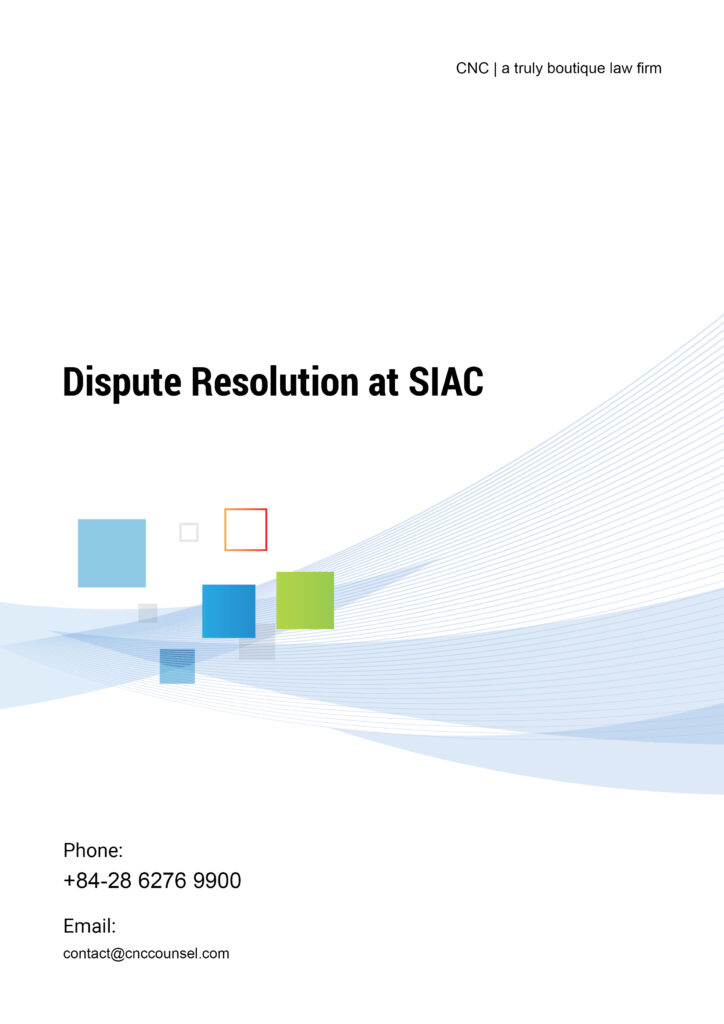Overview of dispute resolution at SIAC
The procedures for dispute resolution at SIAC (“Singapore International Arbitration Centre”) have gathered the attention of most users of arbitration services in Vietnam. According to a 2021 statistic of SIAC, Vietnam is one of five countries with the most disputes accepted for resolution by this institution – with a total number of 55 cases[1].
Therefore, with the goal of providing an overview of the procedures for dispute resolution at SIAC, as well as practical tips for involvement in dispute resolution activities, CNC is honored to introduce the article “Dispute Resolution at SIAC” for our Client’s and potential client’s reference and preparation (if required).
The procedures for dispute resolution provided in this article are limited to the Arbitration Rules of the Singapore International Arbitration Centre 2025 (“2025 SIAC Rules”). The 2025 SIAC Rules are the most recent, updated edition, which went into effect as of January 1, 2025 (01/01/2025)[2], promising revolutionary changes in Dispute Resolution at SIAC
On the other hand, the Investment Arbitration Rules of the Singapore International Arbitration Centre 2017 (“2017 SIAC Rules”) are the first, as well as the most recent version of rules exclusive for Investment Arbitration that SIAC has introduced to its users, which went into effect as of January 1, 2017 (01/01/2017)[3]. For the 2017 SIAC Rules, CNC will prepare a separate article to share about this version.
Similarly, the comparison between SIAC and other large arbitration institutions in the world, such as the International Court of Arbitration of the International Commerce Chamber (“ICC”), The London Court of International Arbitration (“LCIA”), and the Hong Kong International Arbitration Centre (“HKIAC”) will also be introduced by CNC in a subsequent article(s).
Overview of SIAC
SIAC is a not-for-profit arbitration institution – established and officially commenced operation in 1991 – with the primary goal of providing arbitration services in an effective and flexible manner to resolve both international and domestic disputes[4].
Nowadays, SIAC is considered one of the leading institutional arbitration organizations within the Southeast Asia region or even in the entire world[5].
According to the statistics of 2022[6], Trade, Commercial, Corporate, Maritime/Shipping and Construction/Engineering were the main sectors utilizing dispute resolution at SIAC.
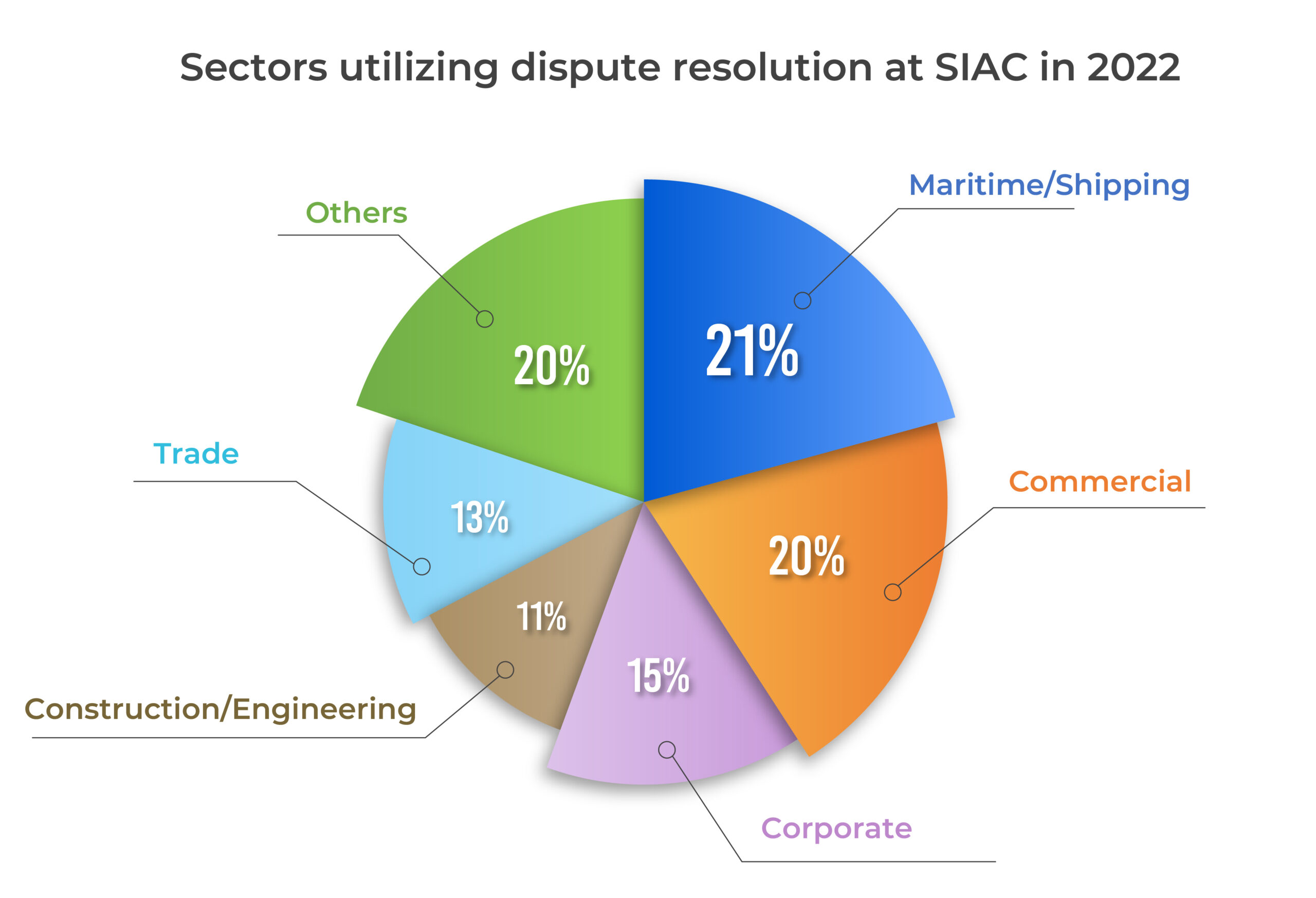
Sectors utilizing dispute resolution
Dispute Resolution at SIAC – Requirements
For SIAC to accept a Case, one Party must demonstrate that there exists an arbitration agreement between the Parties, this arbitration agreement could be an agreement on resolution of either ongoing or potential disputes.
The content of an arbitration agreement for dispute resolution might vary depending on the desires of the Parties and the specifics of each Contract. Parties, however, may refer to the following SIAC Model Clause recommended by SIAC[7]
“Any dispute arising out of or in connection with this contract, including any question regarding its existence, validity or termination, is referred to and finally resolved by arbitration administered by the Singapore International Arbitration Centre (“SIAC”) in accordance with the Arbitration Rules of the Singapore International Arbitration Centre (“SIAC Rules”) for the time being in force, which rules are deemed to be incorporated by reference in this clause.
The seat of the arbitration is [Country].
The Tribunal consists of [___] arbitrator(s).
The language of arbitration is [ ].
The law governing this arbitration agreement is [ ].
This contract is governed by the laws of [ ].”
Concerning the list of open-ended clauses, the Parties are permitted to agree to resolve the dispute at SIAC despite the disputes having already happening, or having occurred.
In other words, whether the disputes occur before or after, the initiation of legal proceedings at SIAC, does not affect SIAC’s jurisdiction to resolve these disputes whatsoever – provided that the Parties have agreed on SIAC’s jurisdiction to resolve these disputes.
Please note, however, that the matter of arbitration jurisdiction of SIAC – in particular and of any arbitration institution in general – is a rather complex issue. To answer whether or not an Arbitral Tribunal established under the 2025 SIAC Rules is competent to resolve a certain dispute is not a simple task.
Aside from the legal validity of the arbitration agreement, the governing law of the contract and the law of the seat of arbitration – namely, Singapore, should also be considered.
Accordingly, to address the question of arbitration jurisdiction of the Arbitral Tribunal, the following questions need to be resolved:
- Is there any arbitration agreement between the parties;
- Whether or not the arbitration agreement between the parties is effective under governing law or Singapore Law;
- If the arbitration agreement is effective under the governing law, but considered null and void under Singapore Law (or vice versa), which law is applicable?;
- Provided that the arbitration agreement between the parties is valid (either under the governing law or the law of the seat of arbitration – Singapore), would the Arbitral Tribunal have jurisdiction over disputes in sectors where dispute resolution via arbitration is not permitted?
- What are the consequences if the Arbitral Tribunal decides that they have jurisdiction over the disputes despite the governing law of the contract or the law of the seat of arbitration – Singapore, specify otherwise?
These complex issues regarding the jurisdiction of the Arbitral Tribunal are analyzed in another article by CNC.
Procedures for Dispute Resolution at SIAC
Although procedures for dispute resolution at SIAC vary and change according to each specific case, fundamentally, the procedures for dispute resolution at SIAC consist of the following four (4) basic phases, each phase with its own, unique, procedural proceedings.
- Phase 1: Commencement of Arbitration
- Phase 2: Establishment of Arbitral Tribunal
- Phase 3: Arbitral Proceedings
- Phase 4: Arbitral Award
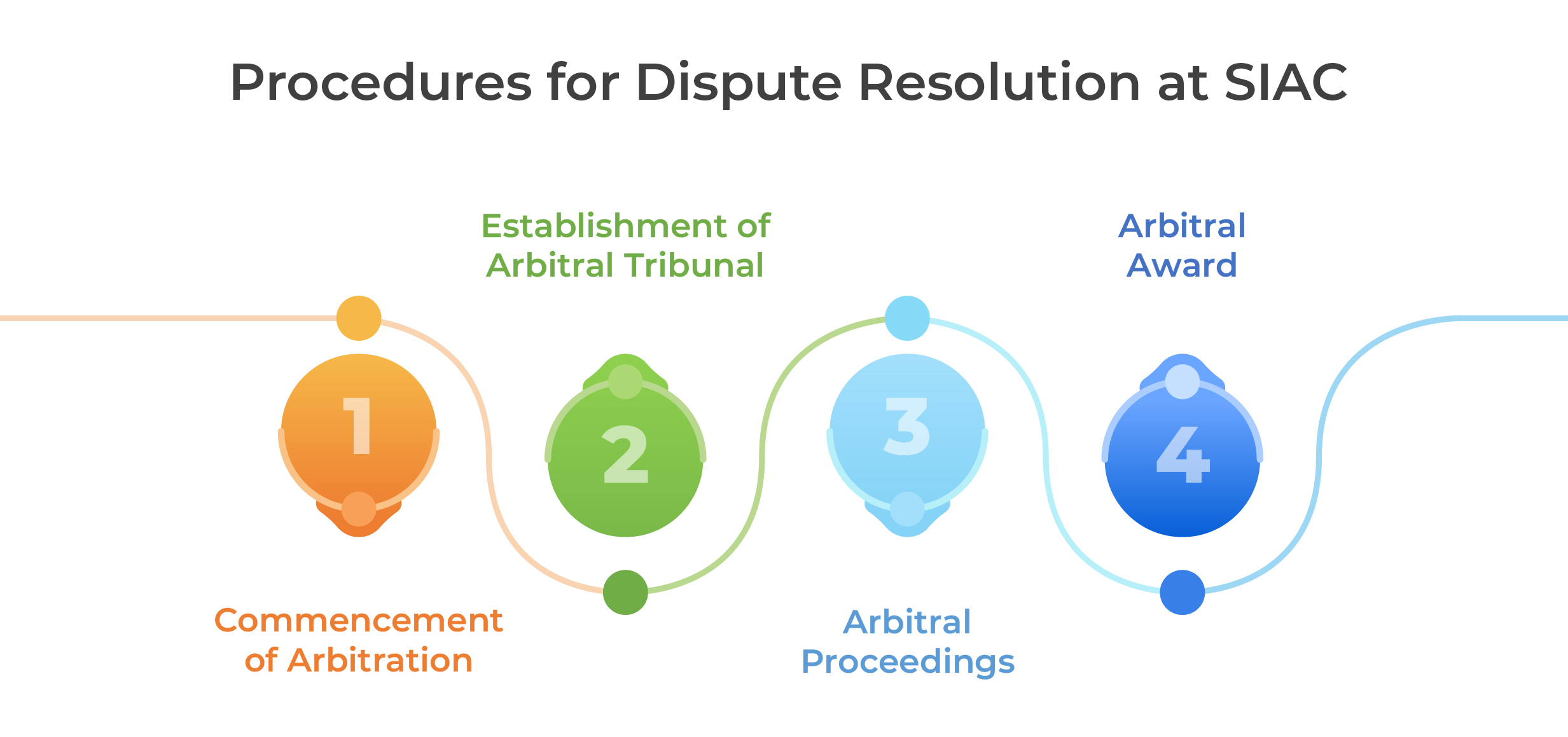 4 phases in Procedures for Dispute Resolution at SIAC
4 phases in Procedures for Dispute Resolution at SIAC
For each of the above phases, certain actions must be taken, including submission of documents, issuance of relevant decisions, or payment of certain amounts.
Therefore, for each specific phase in the Procedures for Dispute Resolution (analyzed and detailed below), CNC provides comprehensive and detailed information in combination with flowcharts and necessary notes.
At the conclusion of this article, CNC assembles and systematizes the details of each phase of Dispute Resolution at SIAC for parties’ ease of reference.
Phase 1: Commencement of Arbitration
In phase 1 – Commencement of Arbitration, users of arbitration services are advised to be keenly aware of three (3) important procedures in Dispute Resolution at SIAC, including (i) Submission of Notice of Arbitration; (ii) Submission of Response to the Notice of Arbitration; and (iii) Prima Facie Determination of Arbitration Jurisdiction.
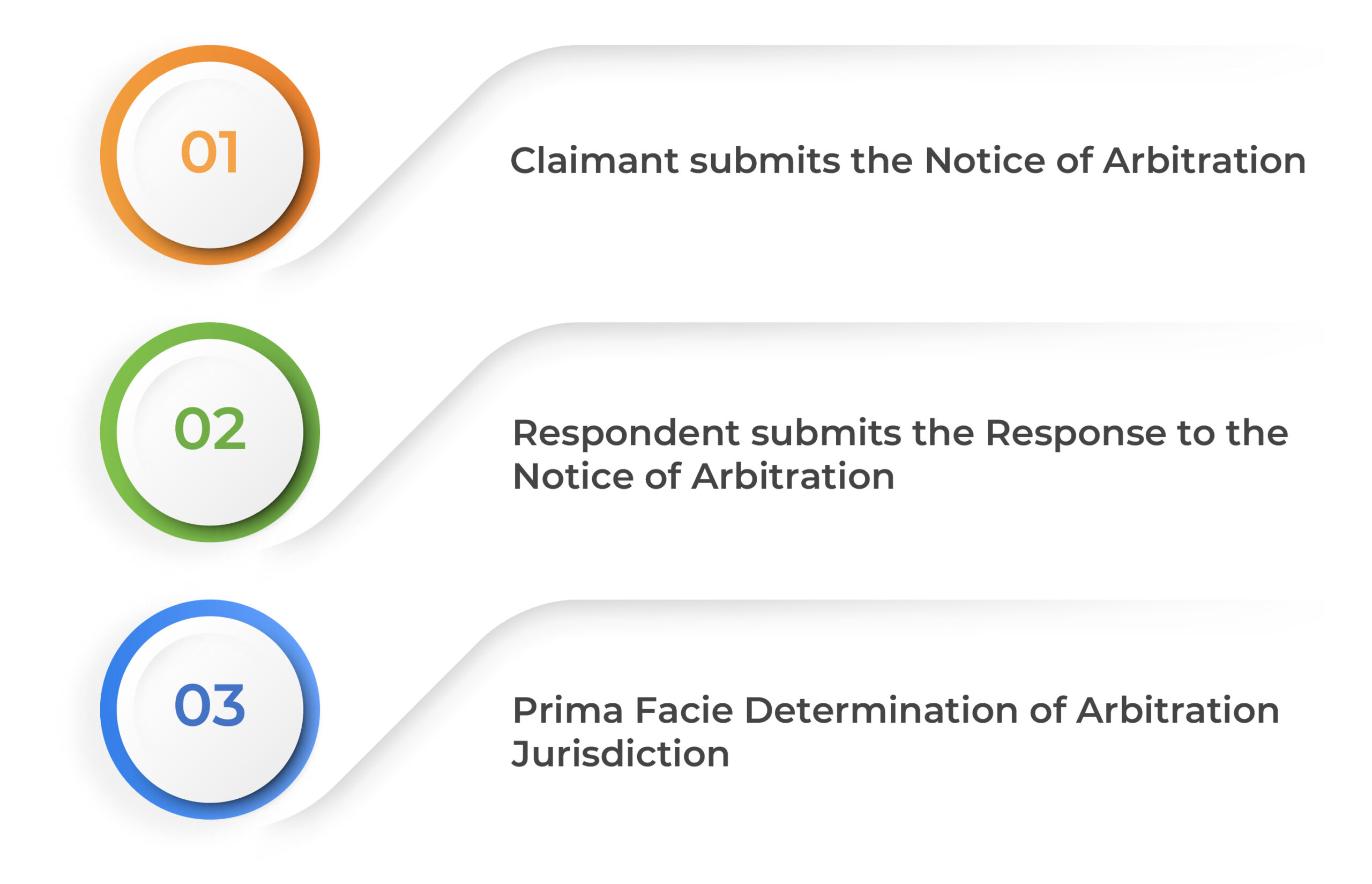
03 important procedures in Dispute resolution at SIAC – Commencement of Arbitration Phase
Regarding the Notice of Arbitration
To commence arbitration under the 2025 SIAC Rules, the Claimant delivers a Notice of Arbitration to the Registrar and the Respondent, which includes the following[8]:
- A demand that the dispute be referred to arbitration;
- Identity and contact details of parties to the arbitration and their representatives, if any;
- Date and mode of delivery of the Notice to Respondent;
- Copy or narrative of the arbitration agreement invoked;
- Copy or narrative of the contract, treaty or other instrument out of or in connection with which the dispute arises;
- Statement describing the nature and circumstances of the dispute, including relief sought and an initial estimate of claim amount;
- Any comment as to the applicable rules of law, seat of the arbitration, language of the arbitration, number of arbitrators, and procedure for the constitution of the Tribunal;
- Statement of existence of any third-party funding agreement and identity and contact details of third-party funder;
- Payment of Claim Filing Fee;
- Any comment on the adoption of amicable dispute resolution methods;
- Statement of Claim.
The Notice of Arbitration could be delivered to SIAC via the email address of the Case Management Team: casemanagement@siac.org.sg or via the case management gateway[9] at: https://siac-gateway.on.opus2.com/.
As the case management gateway has only recently been put into operation, users may not be familiar with its functions, as such, the traditional method of submission, via email, of the Case Management Unit is recommended.
Arbitration is deemed to have commenced on the date of receipt of Notice of Arbitration by the Registrar. Upon which, the Secretariat notifies the parties of the date of arbitration commencement at SIAC.[10]
According to Rule 6.3 and Rule 6.4, of the 2025 SIAC Rules, the Claimant is advised to pay the claim filing fee prior to its submission of the Notice of Arbitration. This is considered a prerequisite condition for the Registrar to consider whether to notify Parties of the commencement date of dispute resolution or not.
The non-refundable claim filing fee (as of 31/12/2024), published by SIAC[11] is S$2,180 SGD (Singapore dollars) for Singapore Parties and S$2,000 SGD (Singapore dollars) for Overseas Parties.
Failure to pay the claim filing fee results in non-commencement of Arbitration at SIAC. However, the Registrar may request – and set a period of time for – the Claimant to pay the case filling fee prior to the notification of the arbitration commencement date to the Parties.
If the Party continues to fail to make payment of the claim filling fee (despite having been allowed an extension of time), the arbitration at SIAC is terminated. However, the termination of arbitration does not affect the Claimant’s right to file a Notice of Arbitration at another appropriate time[12].
Summary: For the Notice of Arbitration to be accepted by the Registrar and for the arbitration to commence at SIAC, the Claimant should follow the steps below:
- Step 1: Prepare the Notice of Arbitration
- Step 2: Deliver Notice of Arbitration to the Respondent
- Step 3: Pay the Claim Filing Fee
- Step 4: Submit Notice of Arbitration to SIAC via the email address[13]: casemanagement@siac.org.sg
- Step 5: Notify the Parties of Commencement of Arbitration via Registrar.
Response to the Notice of Arbitration
Within 14-days from the date of arbitration commencement or the date of the Respondent’s receipt of arbitration notice, whichever is later, the Respondent delivers a Response to the Notice to the Registrar and the Claimant.[14]
The Response to the Notice of Arbitration includes the following:
- The identity and contact details of the Respondent and representatives (if any);
- The date and mode of delivery of the Response to the Claimant;
- A brief statement describing the nature and circumstances of the dispute and a confirmation or denial of all or part of the claims;
- Any objection to arbitration jurisdiction;
- A statement describing the nature and circumstances of any counterclaim, cross-claim, or set-off, including the relief claimed and an initial estimate of the claim amount;
- Any comment as to the applicable rules of law, seat of arbitration, language of arbitration, number of arbitrators, and procedure for the constitution of the Tribunal;
- A statement on the existence of any third-party funding agreement and the identity and contact details of the third-party funder; and/or
- The Statement of Defense and Statement of Counterclaim;
- Any comment on the adoption of amicable dispute resolution methods.
If the Respondent fails or neglects to submit its Response to the Notice of Arbitration, the SIAC Court, the President, the Vice President, the Registrar, or the SIAC Secretariat continues to make decisions and proceed with the administration of arbitration without impediment.[15]
The Respondent may request an extension of the period of time for submission of the Response to the Notice of Arbitration, provided that they have reasonable justifications. In such cases, the Registrar shall be the competent authorities who determine whether to extend or maintain the period of time under the Rules.[16]
Additionally, it should be noted that the Respondent may (but is not obligated to) include the Statement of Defense and Statement of Counterclaim in their Response to the Notice of Arbitration.[17]
All-in-all, in order to make a Response to the Notice of Arbitration, the Respondent considers the following:
- Step 1: Consider whether or not to send a Response to the Notice of Arbitration
- Step 2: If it is decided that a Response to the Notice of Arbitration should be sent, consider whether or not to challenge the jurisdiction of the Arbitral Tribunal
- Step 3: Consider whether or not the time given is enough for the preparation of the response to the Notice of Arbitration
- Step 4: If it is determined that the time given is not enough, submit a request for an extension of time for submission of Response to the Notice of Arbitration
- Step 5: Submit the Response to the Notice of Arbitration as detailed above.
Jurisdictional Objection
A common scenario in Dispute Resolution via Arbitration – in general and at SIAC in particular, – is the objection to the arbitration jurisdiction by one of the parties (e.g. when the Respondent submits the Response to the Notice of Arbitration under Rule 6.3 or when the Claimant submits the Statement of Defense to Counterclaim, 2025 SIAC Rules).
The main reason for the objection to the arbitration jurisdiction by one of the parties revolves around the existence, as well as the practicability of the arbitration agreement[18].
The issue regarding legal validity of the arbitration agreement requires that both parties and the Arbitral Tribunal address lists of crucial legal issues, such as:
- Whether or not an arbitration agreement actually exists;
- If it exists, under what form was the arbitration agreement established (written agreement or verbal agreement)
- What is the applicable law for the validity of the arbitration agreement’
- Is the governing law of the contract also the governing law of the arbitration agreement;
- What are the bases for a certain law to govern the arbitration agreement;
- Does there exist any conflict between the governing law of the arbitration agreement and the law?
In principle, the Arbitral Tribunal possesses the competence to rule on its jurisdiction. The principle of competence, is that competence has earned worldwide recognition, which is demonstrated not only within the academic world and in practice, but also in the stipulation of Article 16, Model Law on International Commercial Arbitration.
However, it should be pointed out that if the Arbitral Tribunal, subsequent to its establishment, ruled that they have no jurisdiction over a certain dispute, it would result in a waste of cost and time.
Therefore, for cases to be managed efficiently, Rule 8.2, 2025 SIAC Rules has empowered the SIAC Court to rule on prima facie determination of arbitration jurisdiction prior to the establishment of the Arbitral Tribunal.
Accordingly, upon one of the Parties (usually the Respondent) raises the matter of arbitration jurisdiction, the Registrar determines whether or not to refer the matter to the SIAC Court.
If the Registrar decides to refer the matter, the SIAC Court receives and provides its determination on whether or not the case could be resolved via Arbitration.
A dispute resolution at SIAC could be terminated prior to the establishment of the Arbitral Tribunal, if the SIAC Court determines that arbitration jurisdiction does not apply to the referred dispute.
Alternatively, if the Registrar or the SIAC Court determines that the arbitration may proceed, the case continues to be administered in accordance with SIAC Rules 2025. This decision is made without prejudice to the power of the Tribunal to rule on its own jurisdiction later on.
In other words, the matter of arbitration jurisdiction is addressed in two steps: (i) Prima facie determination by SIAC Court prior to the establishment of the Arbitral Tribunal, and (ii) Determination by the Arbitral Tribunal subsequent to its Arbitral Tribunal (which shall be elaborated on later)
Overall, in accordance with the SIAC Rules, the objection of arbitration jurisdiction progresses through the following steps:
- Step 1: One of the Parties (usually the Respondent), in Response to the Notice of Arbitration, objects to the arbitration jurisdiction;
- Step 2: The Registrar refers the objection to the SIAC Court for determination;
- Step 3: The SIAC Court determines that the arbitration will not proceed (in whole or in part)
- Step 4: The Registrar terminates the arbitration in accordance with the determination of the SIAC Court
In the event that the Registrar or the SIAC Court decides arbitration might proceed, such decisions would be without prejudice to the power of the Arbitral Tribunal to rule on its own jurisdiction later on.
All of the procedures of Phase 1 are summed up in the following flowchart
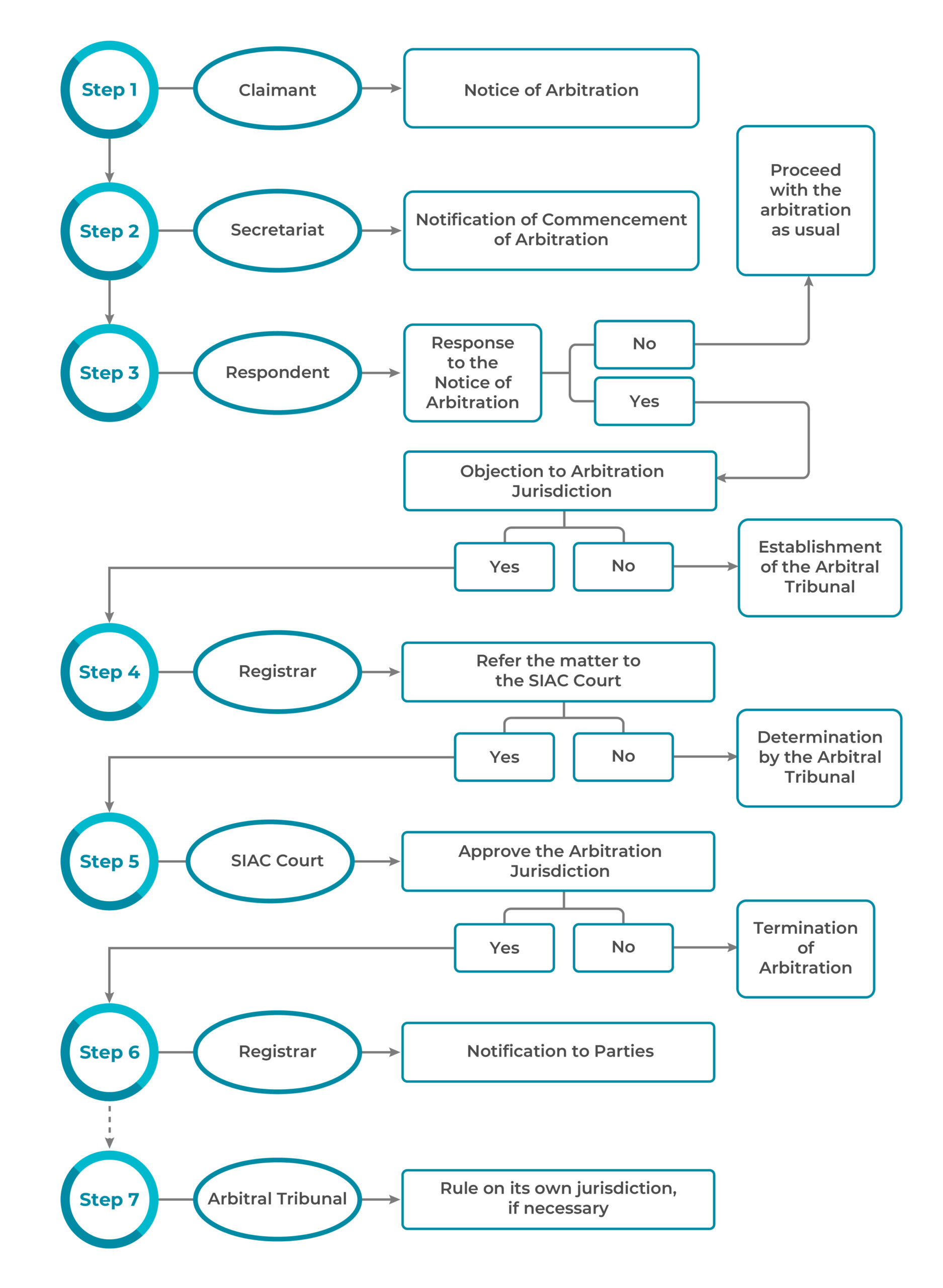
7 basic steps in Dispute Resolution at SIAC – Phase 1: Commencement of Arbitration
Phase 2: Establishment of the Arbitral Tribunal
Regarding establishment of the Arbitral Tribunal, it is imperative that users of arbitration services are keenly aware of the following 3 matters: (i) Number of Arbitrators; (ii) Procedures for the appointment of Arbitrators; and (ii) Challenge of Arbitrators.
Specifically:
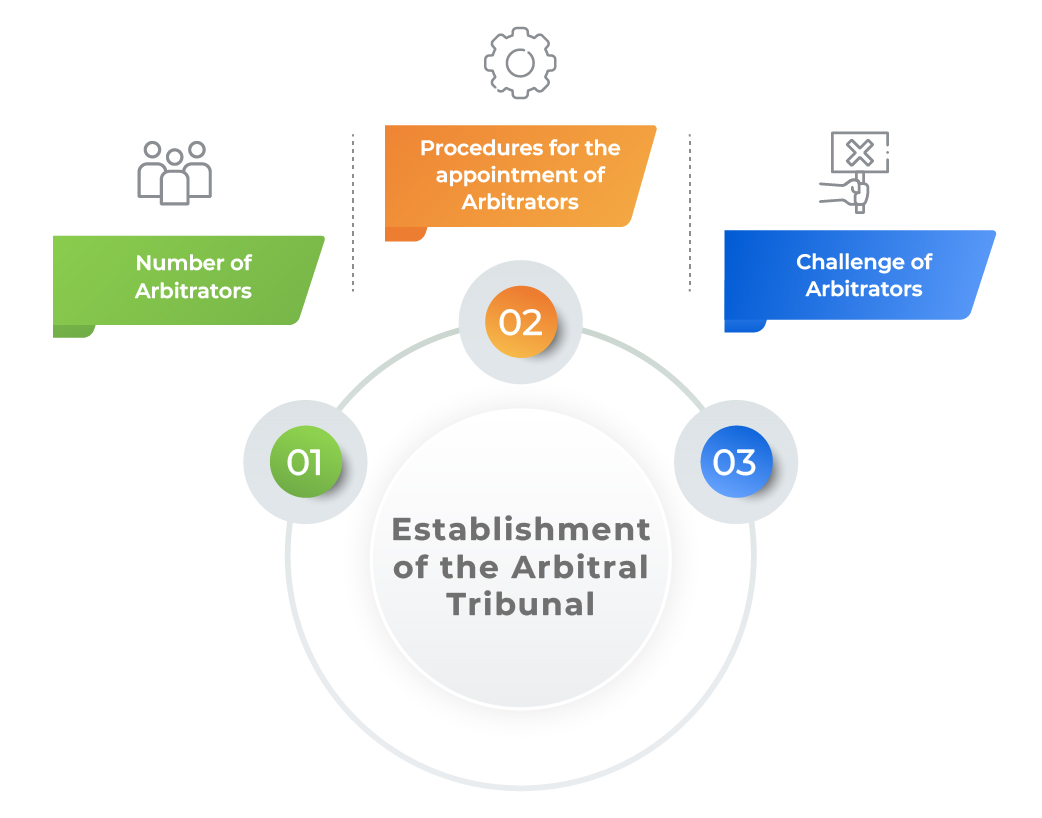
3 main issues in the establishment of the Arbitral Tribunal
Number of Arbitrators
According to the 2025 SIAC Rules, the number of Arbitrators depends on the agreement between the Parties.
However, if parties have no agreement on the specific number of Arbitrators, the number of Arbitrators will be 1 (one) or 3 (three). Accordingly, 1 (one) is the default number of Arbitrators unless the Registrar, after having consulted with the Parties, finds that an Arbitral Tribunal of 3 (three) Arbitrators is required to resolve the Dispute[19].
Evidently, with the default number of Arbitrators being 1 (one), the 2025 SIAC Rules favor a Dispute resolution that is flexible, cost-effective and efficient.
Procedures for the appointment of Arbitrators
Based on the principle of respecting parties’ autonomy, the 2025 SIAC Rules allows the Parties to freely agree on methods and procedures for appointment of Arbitrators. However, any agreement made by parties is considered an agreement under the 2025 SIAC Rules and is subject to the final decision of the President[20].
The decision to either approve or reject the appointment of Arbitrators by parties is considered final and not subject to appeal.[21]
Furthermore, even if an agreement on procedures exists for the appointment of Arbitrators between the Parties, the President maintains the power to make the appointment if the agreed procedures do not achieve their intended purposes[22].
Similarly, if the agreed appointment procedure entails a substantial risk of unequal treatment that may risk the award being set aside, the President may take any necessary measures, including the annulment of the agreement between the parties, to establish an independent and impartial Arbitral Tribunal[23].
Although the number of Arbitrators is as agreed by the Parties or as determined by the Registrar, the appointment of Arbitrators remains consistent with the following fundamental principles[24]:
- First of all, Parties are allowed to appoint or jointly appoint Arbitrators within a certain period of time;
- If necessary, one or all of the Parties may make requests and the Registrar considers whether or not to extend additionally time for the appointment of arbitrators[25]
However, if one of the parties fails to appoint or participate in the appointment of Arbitrators within the allowed time, the President will make the appointment;
- In all instances, the Presiding Arbitrator or the Sole Arbitrator is appointed by the President.
So as to properly fulfill its role, the President will:
- Consult with the Parties prior to issuing any decisions[26]
- Consider the capability, suitability, independence, and impartiality of appointed Arbitrators[27]
- Consider the sufficient availability to conduct the arbitration of the appointed Arbitrator[28]
- Ensure the sole arbitrator or the presiding arbitrator is of a different nationality than the parties[29]
The Arbitral Tribunal is deemed to be established on the date so notified by the Secretariat to the parties[30]
The establishment of the Arbitral Tribunal under 2025 SIAC Rules is summarized in the flowchart below:
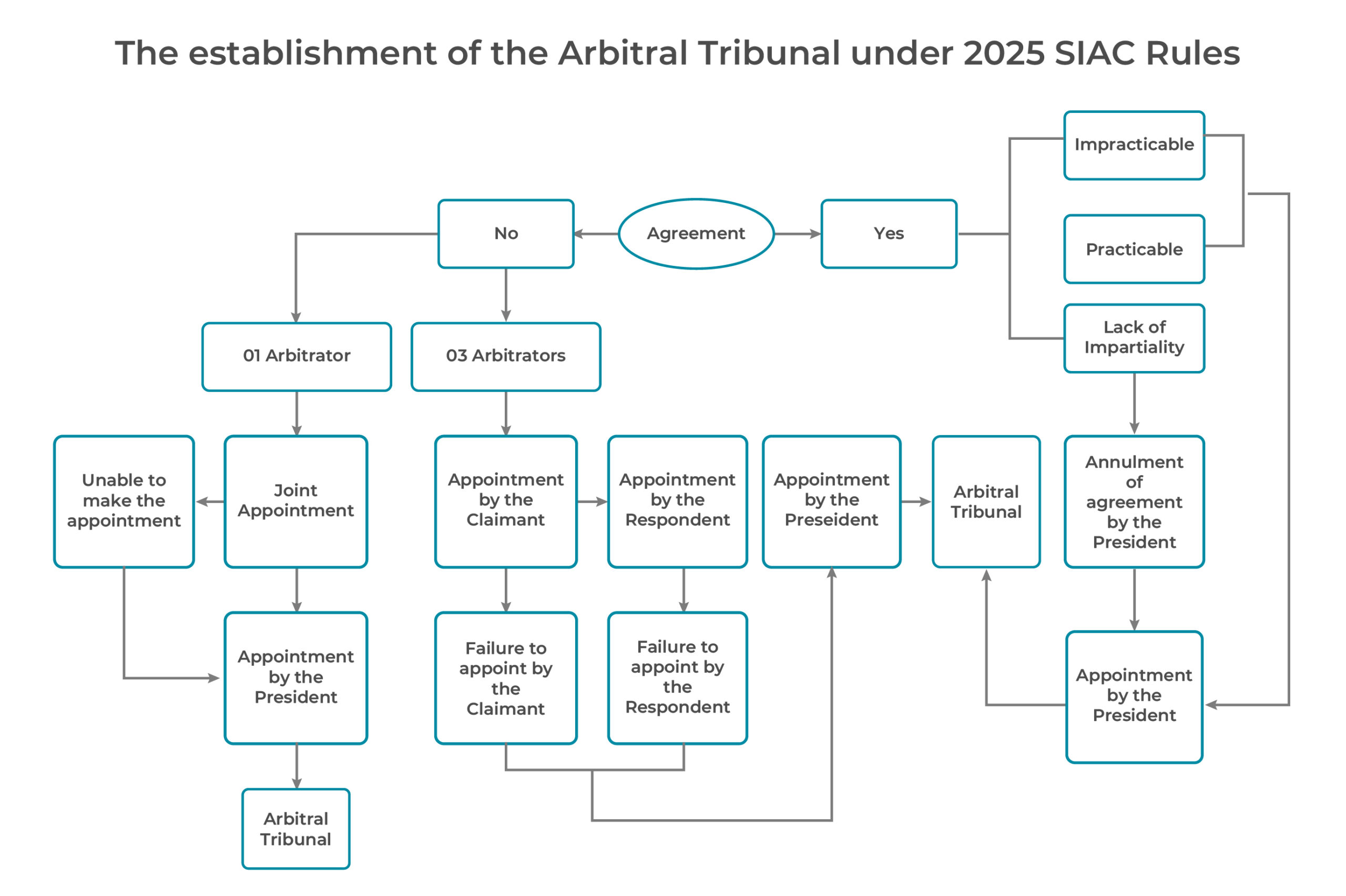
Establishment of the Arbitral Tribunal in Dispute Resolution at SIAC
Challenge of Arbitrators
In order to ensure the independence and impartiality of the Arbitral Tribunal throughout the dispute resolution process, one of the parties may challenge the appointment of any of the Arbitrators. To be specific:
Bases for challenges: challenges may be made if the …
- Circumstances exist that give rise to justifiable doubts as to the arbitrator’s impartiality or independence;
- Arbitrator does not possess any requisite qualification on which the parties have agreed; or
- Arbitrator becomes de jure or de facto – unable to perform his or her functions[31].
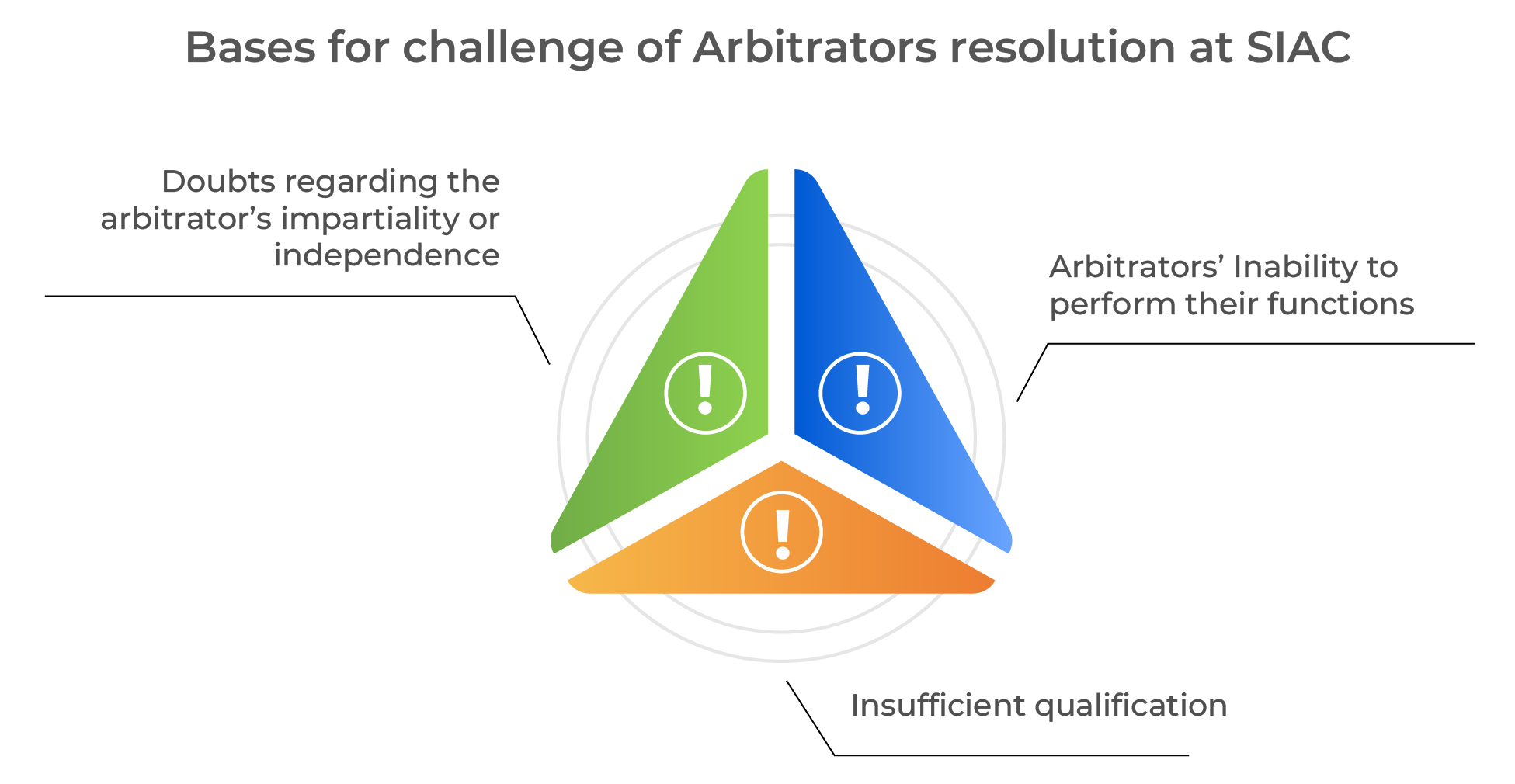
Bases for challenge of Arbitrator in Dispute resolution at SIAC
Notice of Challenge: Must be sent by the Challenging party within 15-days of the …
- Receipt of the notice of appointment of the challenged arbitrator by that party
- Date that the Bases for challenge became known or should have reasonably been known to that party
The notice of challenge of arbitrators shall be sent to the Registrar
Notice of Challenge Review: Upon receipt of the valid notice of challenge and the payment of the challenge filing fee, the Registrar orders the suspension of the dispute resolution until the challenge is resolved.
Removal of the challenged arbitrator: Based on the notice of challenge of one party, the challenged arbitrator will likely be removed from their position in the following 3 instances:
- All other parties agree to the challenge within 7 days of the submission date of the Notice of Arbitration;
- The challenged arbitrator voluntarily withdraws from the Case within 7 days of the submission date of the Notice of Arbitration;
- The SIAC Court, after considering the views of the parties, dismisses the challenged Arbitrator.
Decision on Challenge: The SIAC Court’s decision is delivered by the SIAC Secretariat to the parties, the challenged arbitrator, and any appointed arbitrators. This decision is final and is subject to appeal.
If the challenged arbitrator is removed, the SIAC Court appoints a substitute arbitrator in accordance with Rule 30.1, SIAC Rules 2025[32].
In summary, the procedures for the challenge of arbitrators is condensed into the flowchart below:
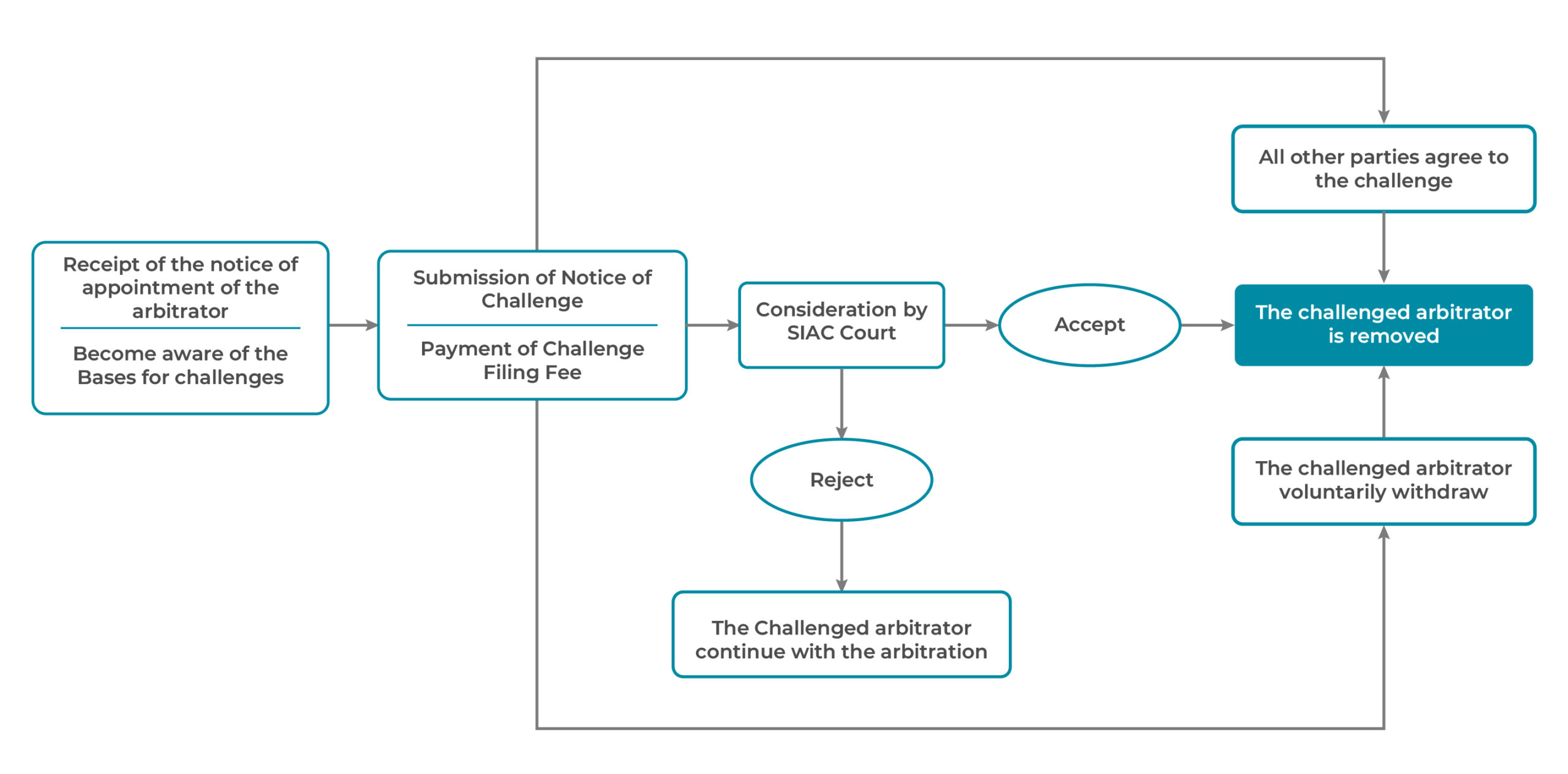
Flowchart for Challenge of Arbitrator in Dispute Resolution at VIAC
Additionally, it should be noted that:
- The SIAC Court may proactively remove arbitrators if it is determined that the arbitrator is not complying with the SIAC Rules or is not conducting the arbitration in a manner that ensures the fair, expeditious, and economical resolution of the dispute[33].
- Furthermore, any of the arbitrators may be replaced by the SIAC Court under Rule 30, 2025 SIAC Rules in the event of the death, incapacity, resignation, withdrawal, or removal of said arbitrator.
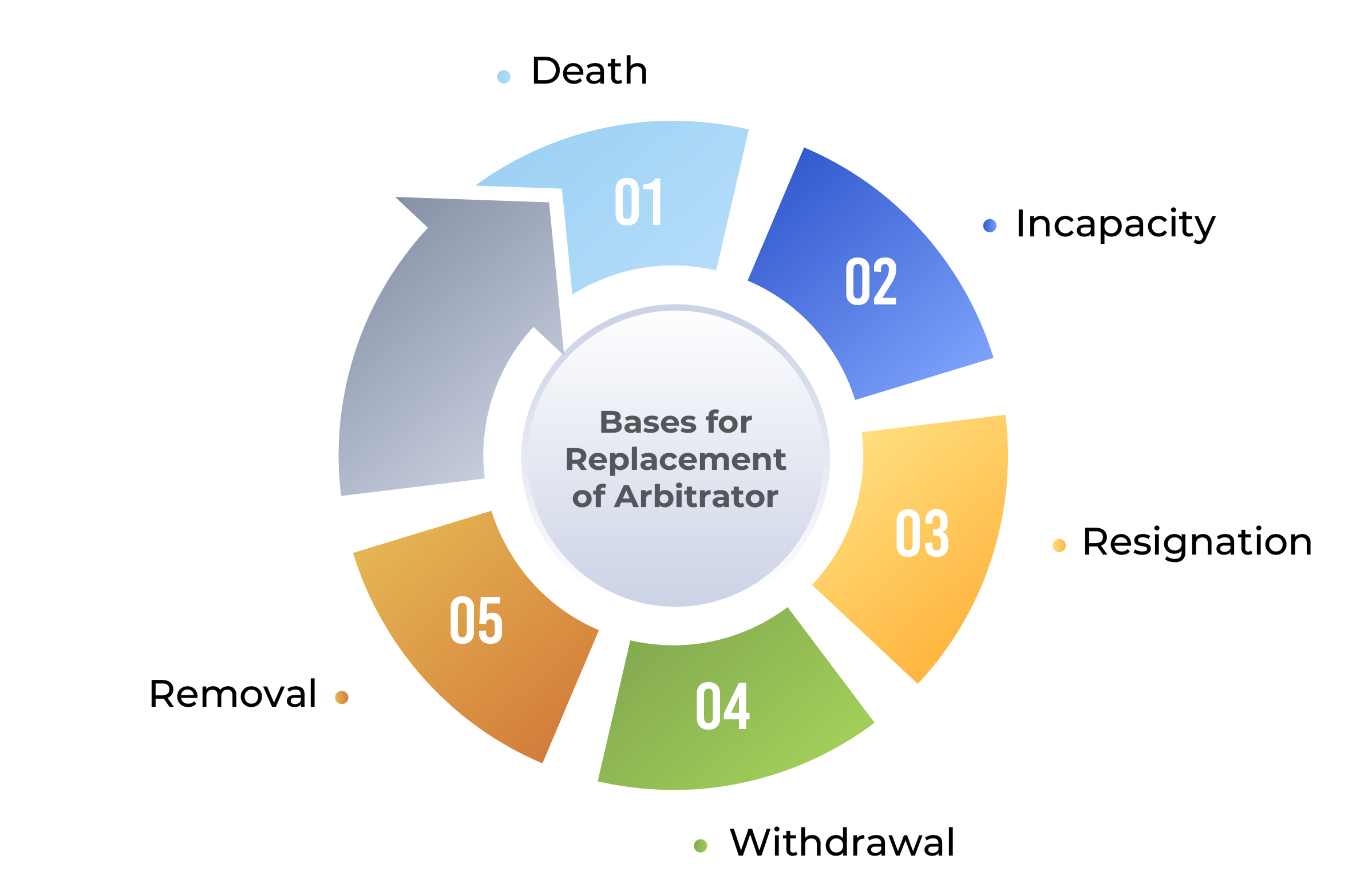
Bases for Replacement of Arbitrator in Dispute resolution at SIAC
Phase 3: Arbitral Proceedings
Subsequent to the constitution and handover of documents and materials of the Case, the Arbitral Tribunal directly manages the Case in a manner that it considers appropriate, which may vary depending on the content, as well as the view of the parties in the Case[34].
However, in general, the actions in arbitral proceedings may be categorized into 5 (five) groups:
- Organization of the case management conference;
- Agreement on schedule of submission and supervision of Parties’ compliance with said submission;
- Employment of appropriate legal measures;
- Organization of Hearings; and
- Closure of the proceeding.
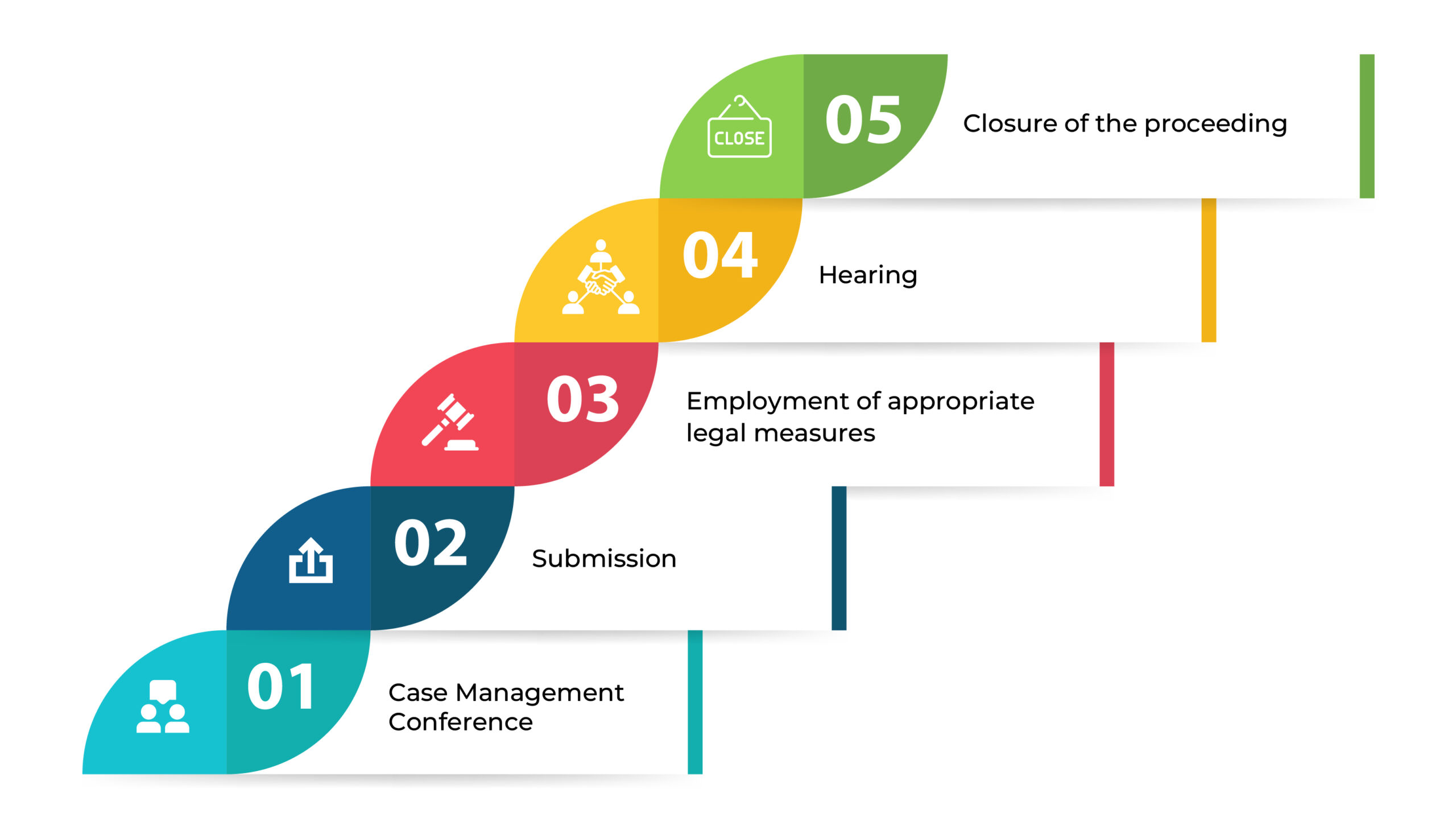
5 main categories of actions in Phase 3: Arbitral Proceedings of Dispute Resolution at SIAC
Case Management Conference
Organization of a case management conference is primarily the first action that all Arbitral Tribunals – following its constitution – take. The purpose of a case management conference is to discuss the procedures that are most appropriate and efficient for the case[35].
Simultaneously, in the case management conference, the Arbitral Tribunal might consult with the parties regarding the adoption of amicable dispute resolution methods or environmentally sustainable procedures for the arbitration.
At any appropriate state, the Arbitral Tribunal may[36]:
- Direct and schedule the order of proceedings
- Bifurcate (separate) the proceedings
- Order page limits on submissions
- Exclude cumulative or irrelevant testimony or other evidence
- Direct the parties to focus their presentations on issues – the determination of which could dispose of all or part of the case
Submission
The submission of Parties ([37]) is done in accordance with the agreed schedule. For each submission, parties need to include[38]:
- A statement of facts supporting the claim;
- The legal grounds or arguments supporting the claim;
- The relief sought
Unless the parties agree otherwise or the Arbitral Tribunal permits otherwise, the submission by parties is performed per the following steps:
- Step 1: Claimant submits the Statement of Claim
- Step 2: Respondent submits the Statement of Defense and/or the Statement of Counterclaim (if any)
- Step 3: Claimant submits the Statement of Defense to Counterclaim (if any); or Claimant submits amendments to the Statement of Claim;
- Step 4: Respondent submits amendments to the Statement of Defense and/or amendments to the Statement of Counterclaim (if any); or Claimant submits amendments to the Statement of Defense to Counterclaim (if any)
Moreover, each party might request the Arbitral Tribunal to allow amendments to previous submissions, provided that the amendments are within the original scope and do not hinder the arbitral proceedings. The sole and final decision belongs to the Arbitral Tribunal[39].
Similarly, the Arbitral Tribunal, after considering the views of the parties, decide which further submissions are required from the parties or may be presented by them so that the dispute is resolved in an accurate and transparent manner[40].
As such, the submission of Parties is summarized as follows:
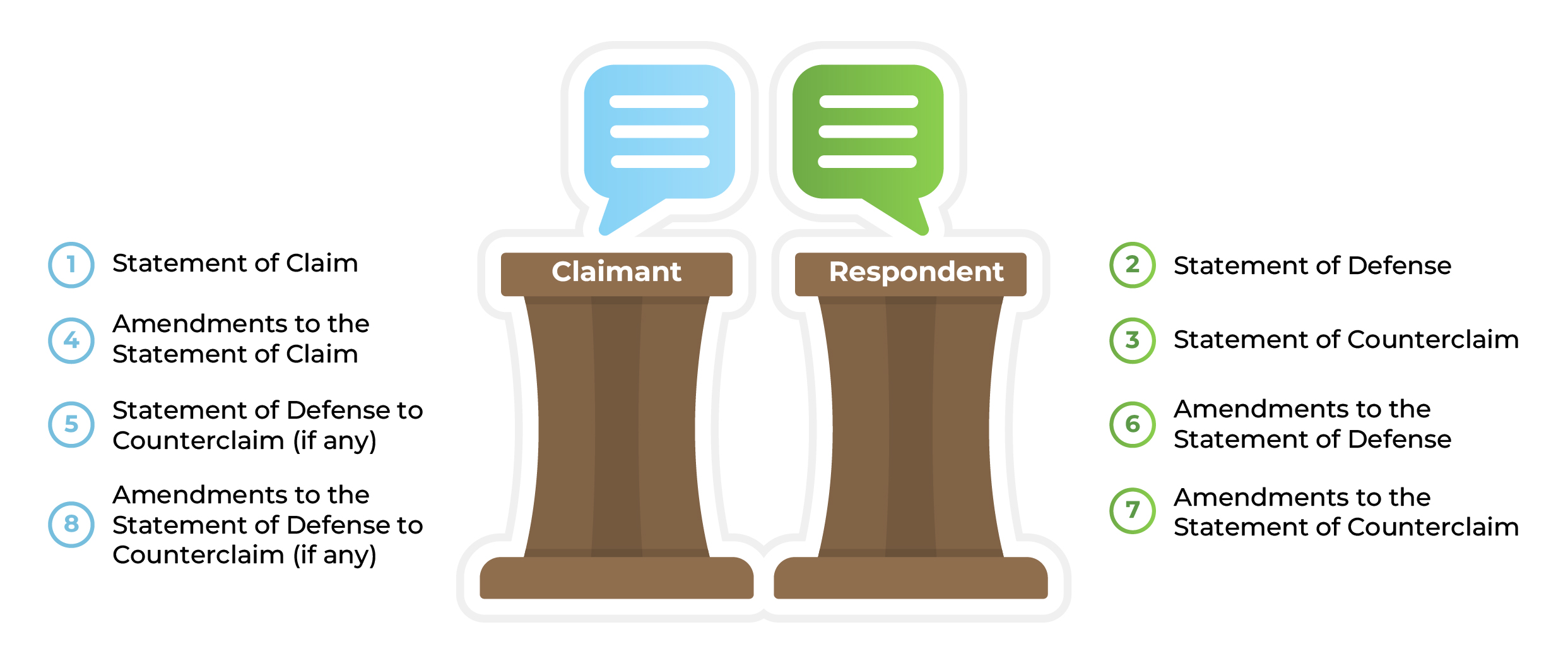
Submission of parties in Dispute Resolution at SIAC
Appropriate Legal Measures
Aside from reviewing and assessing the submissions of the Parties, the Arbitral Tribunal might also take appropriate legal measures to optimize the effects of dispute resolution via Arbitration, for example:
Interim Relief[41]
Preliminary Determination[42], which is applicable when
- Requested by one of the parties
- The parties agree that the Tribunal might issue Preliminary Determinations;
- The requesting parties is able to demonstrate that the determination of the issue on a preliminary basis is likely to contribute to savings of time and costs and a more efficient and expeditious resolution of the dispute
- The circumstances of the case otherwise warrant preliminary determinations;
Early Dismissal of Claims and Defenses[43], which is applicable when
- Requested by one of the parties;
- A claim or defense is manifestly without legal merit or outside the jurisdiction of the Tribunal
Once requests for early dismissal are made, the arbitral proceeding may be concluded prematurely, if the Arbitral Tribunal are convinced that such requests are meritorious, however, the request for early dismissal may only serve to prolong the arbitral proceedings.
Security for Costs: Based on the request of one party, the Arbitral Tribunal might order that any party asserting a claim, counterclaim, or cross-claim, provide security for legal costs and expenses, as well as the costs of the arbitration[44]
Security for Claims: Based on the request of one party, the Arbitral Tribunal might order that any party responding to a claim, counterclaim, or cross-claim provide security against the relevant claim[45]
Order any party to produce documents at the request of the other party[46]. This procedure is often performed during the submission of parties
Hearings[47]
Unless the parties agree that disputes are likely to only be resolved via submission, the Arbitral Tribunal conducts hearings to resolve the disputes.
Hearings are opportunities for the Arbitral Tribunal to listen to the presentations of the parties, witnesses, or even expert witnesses. This would allow the Arbitral Tribunal to clarify issues that are not explained or explained clearly in the submission of Parties.
The Arbitral Tribunal sets the date, time, and format of the hearings and notifies the Parties.
The format of the hearings could be conducted in person, in the form of electronic communication, or a combination of both, as long as the confidentiality provisions of Rule 59, SIAC Rules 2025 are maintained.
The Arbitral Tribunal selects appropriate locations to conduct the hearings.
Closure of the Proceedings
For matters that require Arbitral Awards to be rendered, as soon as practicable after the last hearing or submission of parties, as well as after the Arbitral Tribunal finds that the parties have no further relevant and material evidence to produce or submissions to make, the Arbitral Tribunal declares the proceedings closed. The closure of the proceedings needs to be sent to the Parties and the Secretariat[48]
However, the Arbitral Tribunal may, on its own motion or upon application of a party, reopen the proceedings. In such cases, the Arbitral Tribunal provides notice to the Parties and the Secretariat.[49]
Overall, the arbitral proceeding phase is summed up in the following steps:
- Step 1: The Arbitral Tribunal receives the cases from the Secretariat and the case management team.
- Step 2: The Arbitral Tribunal consults with parties to organize the case management conference
- Step 3: The Arbitral Tribunal and Parties agree or disagree on the disputes needing to be resolved and schedule for submission.
- Step 4: Parties make submissions in accordance with the agreed schedule.
- Step 5.1: If deemed necessary, subsequent to the first submission, one of the Parties might request the other parties to provide documentation that the former believes are currently in the latter possession to serve as the basis for further submissions.
- Step 5.2: The requested party provides documentation as requested.
- Step 6.1: If the requested party does not provide documentation, the requesting party may appeal to the Arbitral Tribunal for an order to obligate the requested party to provide said documentation.
- Step 6.2: If deemed necessary, one of the parties might request the Arbitral Tribunal to take appropriate legal measures
- Step 7.1: The Arbitral Tribunal will, after considering the request and the provided security of the requesting party, either accept or reject the request for application of appropriate legal measures.
- Step 7.2: The Arbitral Tribunal might issue preliminary determinations to resolve parties’ requests
- Step 8: The Arbitral Tribunal conducts hearings with Parties
- Step 9: The Arbitral Tribunal announces the closure of the arbitral proceedings
Phase 4: Arbitral Award
In principle, the Arbitral Tribunal may possibly issue more than one award at any point in time during the arbitration process[50]. Accordingly, the issuance of an Arbitral Award would go through the following steps:
- Drafting of Arbitral Awards;
- Scrutiny of Arbitral Awards;
- Issuance of the arbitral award;
- Correction of Arbitral Awards (if any)
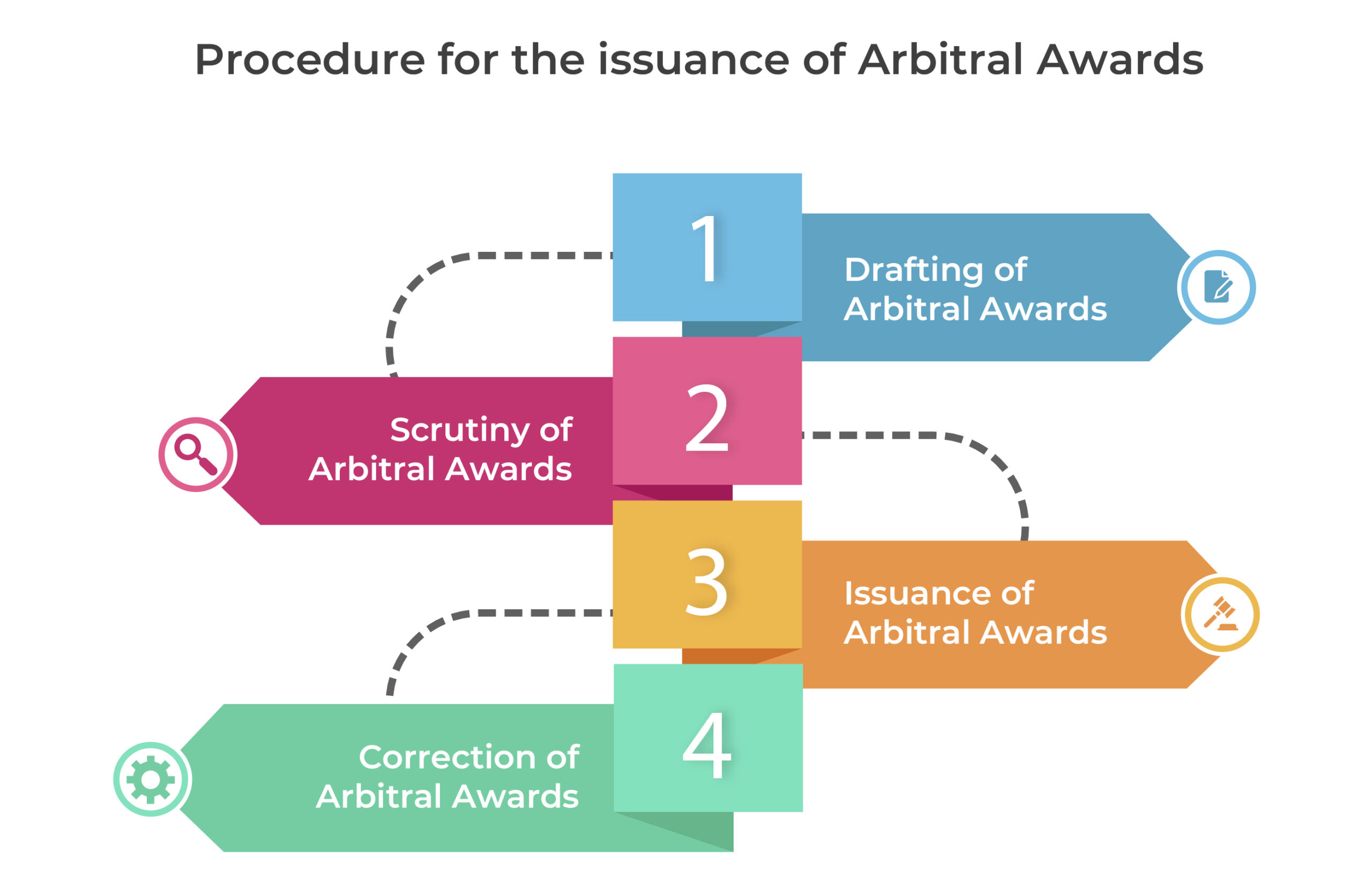
Drafting of Arbitral Awards
Within 30 days of the most recent hearing or submission of the Parties, the Arbitral Tribunal provides the parties and the Secretariat with an estimated amount of time within which it proposes to submit the draft award for scrutiny[51]
Unless the Registrar decides otherwise, the Arbitral Tribunal must provide the Secretariat with the draft award within 90 days of the last hearing or submission of the Parties for scrutiny by the Registrar[52]
Scrutiny of Arbitral Awards
Upon receipt of the draft award, the Registrar proceeds to review the format of the Arbitral Award and, without affecting the Arbitral Tribunal’s liberty to decide the dispute, draw the Arbitral Tribunal’s attention to the points of substance of the draft award[53]
There is no specific time limit for the Registrar to perform the Scrutiny of Arbitral Awards. Parties are made aware of the completion of Arbitral Award scrutiny by the Registrar upon receipt of the notice from the Secretariat.
However, no award is issued until its form has been approved by the Registrar[54].
Issuance of Arbitral Awards
The Arbitral Tribunal only issues Arbitral Awards post completion of the Scrutiny of Awards[55].
The Arbitral Award is issued by a majority, or, failing a majority decision, the presiding arbitrator issues the Arbitral Award[56]. Accordingly, the arbitrators sign the arbitral award and any arbitrator whose signature is omitted must have their reason stated in the arbitral award.[57]
In the event of the final award, unless otherwise agreed by the parties, the content of the award must contain the Registrar’s determination of the costs of the arbitration and the Arbitral Tribunal’s decision on the apportionment of the costs of the arbitration[58].
Subsequent to the receipt of the arbitral award from the Arbitral Tribunal, the Secretariat delivers the arbitral award to the parties upon settlement of the costs of the arbitration.[59]
For any party involved in dispute resolution at SIAC, in particular or at any other arbitration in general, the receipt of arbitral awards is perhaps the greatest reward for their endeavor.
Correction of Arbitral Awards
While the correction of arbitral awards is undesirable for any party involved in dispute resolution at SIAC, considering the complexity and the lengthy duration of the dispute, arbitral awards might not be able to completely reflect the exchange between the parties in some instances.
Therefore, the 2025 SIAC Rules state that within 30 days of the receipt of the Arbitral Award, the parties notify the Registrar, Arbitral Tribunal, or other party and request the Arbitral Tribunal to correct the Arbitral awards in any of the following cases:[60]
Correction of Arbitral Awards: applicable to any errors in computation, any clerical or typographical errors, or any errors of similar nature. Accordingly, the Arbitral Tribunal processes such corrections within 30 days from the date of receipt, if it considers the request to be justified. Alternatively, the Arbitral Tribunal could, on its own initiative, correct any of the errors in the arbitral award.
Interpretation of arbitral awards: applicable to a specific point or part of the arbitral award that requires clarification. Accordingly, the Arbitral Tribunal provides written interpretations within 30 days from the date of receipt of the request, if it considers the request to be justified.
Additional awards: applicable to claims presented in the arbitration but not addressed in the award. Accordingly, the Arbitral Tribunal provides the additional award within 60 days from the date of receipt of the request, if it considers the request to be justified.
The Registrar may extend the period of time for which the Tribunal may make a correction of an award, interpretation of an award, or an additional award[61].
For the correction, interpretation, and issuance of additional awards, the Arbitral Tribunal will proceed in a manner similar to the issuance of Arbitral Awards[62].
The Registrar will determine if additional costs of arbitration are applicable to the correction of arbitral awards, interpretation of arbitral awards, or issuance of Additional Awards.[63]
Overall, these are the steps in Phase 4 – Arbitral Award of Dispute Resolution at SIAC:
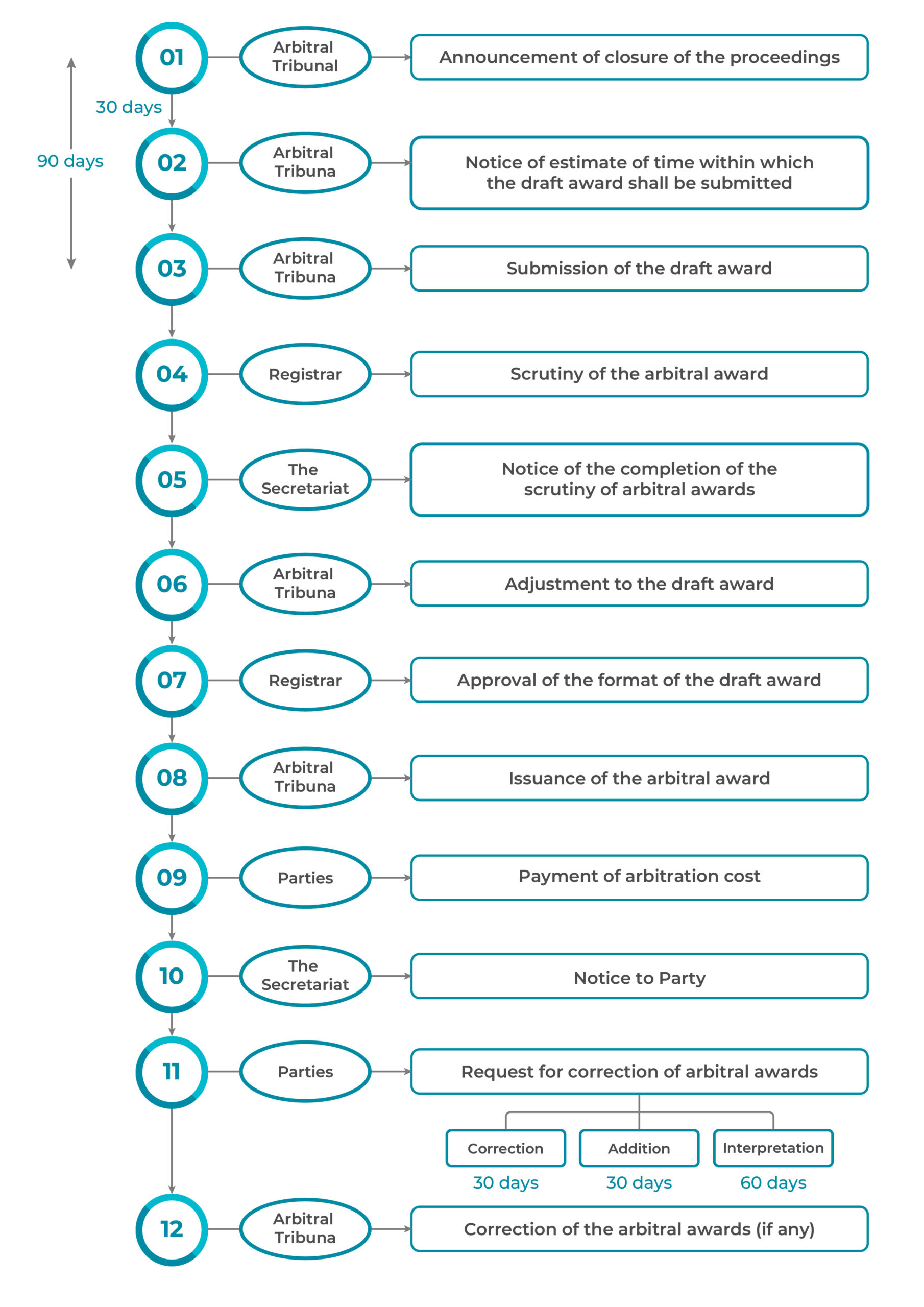
12 Steps in the Issuance of Arbitral Award
Conclusion on Dispute Resolution at SIAC
Evidently, dispute resolution at SIAC – under the 2025 SIAC Rules – has become more efficient and flexible in comparison to the previous rules, most notably for complex and multi-faceted disputes. This demonstrates SIAC’s commitment to providing dispute resolution services on an international scale in a cost-effective manner and further affirms SIAC’s reputation in comparison to other arbitration institutions within the region.
Currently, the Singapore International Arbitration Center is known as one of the arbitration institutions with the most explosive growth and efficient dispute resolution results worldwide. Their staff and arbitrators are highly rated for their expertise in arbitration.
With the above, CNC hopes that this article “Dispute Resolution at SIAC” provide Clients with useful information on dispute resolution via arbitration in general and dispute resolution at SIAC in particular.
Managed by
 |
Mr. Le The Hung | Managing Partner
Phone: (84) 916 545 618 Email: hung.le@cnccounsel.com |
 |
Mr. Tran Pham Hoang Tung | Partner
Phone: (84) 901 334 192 Email: tung.tran@cnccounsel.com |
Contact
To learn more about Dispute Resolution at SIAC, especially under the SIAC Rules 2025, please contact:
CNC VIETNAM LAW FIRM CO., LTD
Address: 28 Mai Chi Tho Street, An Phu Ward, Thu Duc City, Ho Chi Minh City, Vietnam
Phone: (84) 28-6276 9900
Hotline: (84) 916 545 618
Email: contact@cnccounsel.com
Website: cnccounsel.com
Disclaimers:
This article was prepared to be used for the purpose of introducing or informing clients about issues and/or developments of legal perspectives in Vietnam. The information presented in this article does not constitute advice of any kind and may be subject to change without prior notice.
[1] See more: https://siac.org.sg/wp-content/uploads/2022/06/SIAC-AR2021-FinalFA.pdf
[2] See more: https://siac.org.sg/siac-rules-2016
[3] See more: https://siac.org.sg/siac-investment-rules-2017
[4] See more: https://siac.org.sg/about-us
[5] See more: https://siac.org.sg/faqs/siac-general-faqs
[6] See more: https://siac.org.sg/wp-content/uploads/2022/06/SIAC-AR2021-FinalFA.pdf
[7] See more: https://siac.org.sg/siac-model-clause
[8] Rules 6.3 and 6.4, SIAC Rules 2025
[9] For more details, please look up the frequently asked questions of the online case management system via this link: https://siac.org.sg/faqs/siac-gateway-faqs
[10] Rule 6.2, SIAC Rules 2025
[11] See more: https://siac.org.sg/siac-schedule-of-fees
[12] Rule 6.6, SIAC Rules 2025
[13] Currently, the online system introduced by SIAC has been put into operation. The Claimant might submit the Notice of Arbitration via the address: https://siac-gateway.on.opus2.com/. However, the traditional form of submission is via the email address of the case management team.
[14] Rule 7.1, SIAC Rules 2025
[15] See Rule 7.4, SIAC Rules 2025
[16] See Rule 5.3, SIAC Rules 2025
[17] See Rule 7.2, SIAC Rules 2025
[18] See Rule 8.1, SIAC Rules 2025
[19] Rule 19.1, SIAC Rules 2025
[20] Rules 19.2 and 19.4, SIAC Rules 2025
[21] Rule 19.13, SIAC Rules 2025
[22] Rule 19.9, SIAC Rules 2025
[23] Rule 19.10, SIAC Rules 2025
[24] Rules 21, 22, and 23, SIAC Rules 2025
[25] Rule 19.8, SIAC Rules 2025
[26] Rules 19.4, 19.7, and 19.10, SIAC Rules 2025
[27] Rule 19.5, SIAC Rules 2025
[28] Rule 19.6, SIAC Rules 2025
[29] Rule 19.7, SIAC Rules 2025
[30] Rule 19.12, SIAC Rules 2025
[31] Rule 26, SIAC Rules 2025
[32] Rules 27.5 and 28.2, SIAC Rules 2025
[33] Rule 29, SIAC Rules 2025
[34] Rule 32.2, SIAC Rules 2025
[35] Rule 32.4, SIAC Rules 2025
[36] Rule 32.6 and 34, SIAC Rules 2025
[37] Rule 33.7, SIAC Rules 2025
[38] Rules 33.2 to 33.4, SIAC Rules 2025
[39] Rule 33.5, SIAC Rules 2025
[40] Rule 33.6, SIAC Rules 2025
[41] Article 17, Arbitration Model Law
[42] Rule 46, SIAC Rules 2025
[43] Rule 47, SIAC Rules 2025
[44] Rule 48, SIAC Rules 2025
[45] Rule 49, SIAC Rules 2025
[46] Rule 50.2(f), SIAC Rules 2025
[47] Rule 39, SIAC Rule 2025
[48] Rule 42.1, SIAC Rules 2025
[49] Rule 42.2, SIAC Rules 2025
[50] Rule 51, SIAC Rules 2025
[51] Rule 53.1, SIAC Rules 2025
[52] Rule 53.2, SIAC Rules 2025
[53] Rule 53.3, SIAC Rules 2025
[54] Rule 53.4, SIAC Rules 2025
[55] Rule 53, SIAC Rules 2025
[56] Rule 51.2, SIAC Rules 2025
[57] Rule 52.1, SIAC Rules 2025
[58] Rule 51.4, SIAC Rules 2025
[59] Rule 52.5, SIAC Rules 2025
[60] Rule 54, SIAC Rules 2025
[61] Rule 54.5, SIAC Rules 2025
[62] Rule 54.6, SIAC Rules 2025
[63] Rule 54.7, SIAC Rules 2025



